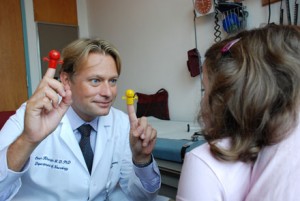
Khwaja evaluates a young girl with Rett syndrome, the leading known genetic cause of autism in girls.
In 2007 an extraordinary paper was published, suggesting that developmental disorders, including autism spectrum disorders, aren’t necessarily a done deal. Working with a mouse model of Rett syndrome, a disorder causing severe cognitive, motor and language problems and autistic behaviors, mostly in girls, researchers in Scotland restored the function of MeCP2, the mutated gene. The mice showed a striking reversal of their neurologic symptoms.
The paper has had an impact around the world, changing how scientists think about disorders that have been thought to be untreatable. Typically, girls with Rett start developing normally, but sometime between age 1 and 2 they begin to lose their blooming language and motor skills. Until recently, Rett was viewed as a degenerative disease, with a gradual, irreversible loss of brain cells. “It was thought that if there ever was a treatment, it would have to be given before symptoms appeared, and that once the disease started it couldn’t be reversed,” says Omar Khwaja, a neurologist at Children’s Hospital Boston.
But in fact, research has shown that neurons aren’t lost. Instead, the synapses—the points of communication between brain cells—fail to mature, are unstable and are ultimately lost, impairing learning ability. And it appears these lost connections can be restored, at least in mice.
Last week, Khwaja and colleagues announced the opening of a randomized clinical trial, funded by the International Rett Syndrome Foundation, Autism Speaks and Harvard Catalyst. Forty girls with Rett syndrome, age 2 to 12, will receive insulin-like growth factor-1 (IGF-1), a human hormone used mainly to treat short stature. IGF-1 is indirectly regulated by MeCP2, and in the laboratory, it has been shown to enhance synapse maturation, and it has ameliorated several features of Rett-like disease in mice.
“There’s been a big sea change in how Rett syndrome and other neurodevelopmental disorders are viewed,” Khwaja says. “The synapses are very dynamic. They need to be stabilized, and if they don’t receive the right stimulus, they’ll naturally disappear. That change in paradigm has really affected the way that we look at treatments, and I think it brings a lot more hope.”
Rett syndrome is only the first of several neurodevelopmental disorders that appear amenable to change. As genetic disorders causing cognitive and autism-like impairments are becoming better understood, scientists are finding biochemical pathways that can be targeted by drugs. Tomorrow’s post will explore this trend in more detail.






